
views
X
Research source
Finding Free Online Resources

Start with a Foreign Service Institute (FSI) short course. The FSI was created by the US State Department to teach embassy employees how to speak the local language. Many of these materials are available online through the Live Lingua Project, including a short course on Bengali. The Bengali short course materials are available for download at https://www.livelingua.com/course/fsi/Bengali_Short_Course. While this short course won't get you anywhere near fluency, it can serve as a good introduction and allow you to carry on basic conversations in Bengali. Live Lingua also has the US Peace Corps Bengali course, available for free at https://www.livelingua.com/project/peace-corps/Bengali/.

Check out the free materials offered by the Defense Language Institute. The Defense Language Institute Foreign Language Center of the US Department of Defense has cultural orientation programs and survival language packs that can teach you basic Bengali language skills. Go to https://fieldsupport.dliflc.edu/productList.aspx?v=co to get started. Scroll down until you see the entry for Bengali. There are links to the different resources that are available. Despite the fact that these are categorized on the page as "products," everything can be accessed or downloaded for free. While most of the materials are intended for military personnel deployed overseas, there are basic guides that would be helpful for any student of the language. For example, the Bengali Cultural Orientation program will give you a better understanding of the country of Bangladesh as well as Bengali culture and traditions. This knowledge will give you a deeper appreciation and understanding of the language.

Listen to Bengali poetry and prose. Listening to Bengali literature read aloud by native speakers can help you immerse yourself in the language. It will also give you a greater feel for the natural sound and rhythm of the language. You can listen to Bengali authors reading their own work for free at http://www.loc.gov/acq/ovop/delhi/salrp/bengali.html. This site is part of the South Asian Literary Recordings Project, run by the US Library of Congress New Delhi Office. Find more audio recordings available for free online by doing an online search for "Bangla audio," "Bangla radio," "Bangla podcasts," or similar.

Use social networks to connect with Bengali speakers. Search for Bengali language forums and pages you can follow to interact with Bengali speakers and students. For instance, there’s a sea of language learning accounts for different languages on Instagram. You can use their posts as flashcards. And, very often the posts on Instagram are well designed and visually appealing. Reddit also has a Bengali language forum available at https://www.reddit.com/r/bengalilanguage/. There are a number of videos posted that can help you learn basic grammar and vocabulary. Advanced students and native speakers also participate in this forum to help beginners who want to learn the language.
Mastering the Bengali Alphabet
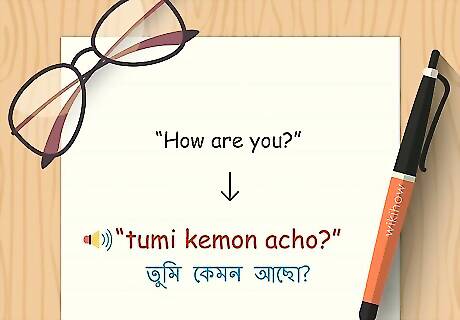
Start with transliterations before learning script. Especially if your focus is conversation rather than reading and writing, you'll learn a lot more quickly if you use transliterated text rather than trying to learn Bengali script and speak at the same time. With transliteration, you'll be able to learn new words and communicate in the language more quickly. Then, as you transition to Bengali script, you can start writing words immediately.
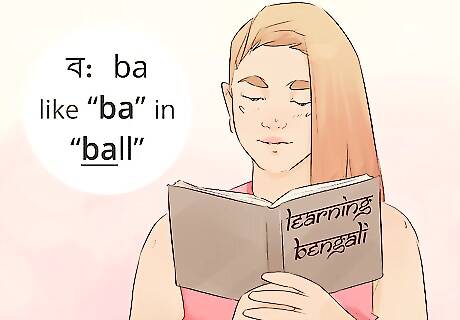
Memorize the pronunciation of Bengali letters. Since Bengali has a syllabic alphabet, once you know the sounds the letters make you can easily sound out words you don't know. You may not know the definition, but you'll know how to pronounce it. There is also a transliteration schema available on the Virtual Bangladesh website with comparisons of the sounds to English words. Go to http://www.virtualbangladesh.com/bengali-tutorial/bengali-tutorial-transliteration-schema/ to view or print it.

Familiarize yourself with Bengali script. Bengali is traditionally written in a cursive script. The alphabet has 12 vowels and 52 consonants. Bengali is a syllabic language, so every letter has a full sound associated with it. While there are separate vowels, each consonant has its own inherent vowel. Vowels can be written either as separate letters, or by using various marks around the consonant to indicate how it should sound. Because the Bengali alphabet is closely related to the Devanagari alphabet, you may find it easier to learn if you are already familiar with the Devanagari script, which is used in Hindi, Sanskrit, and many other Indo-Aryan languages.
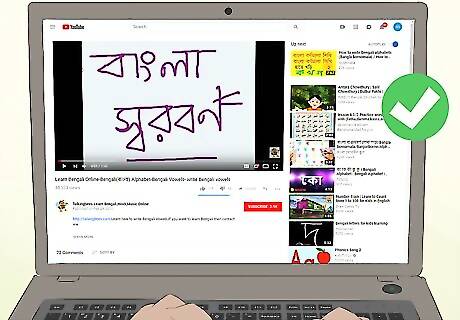
Watch videos to learn Bengali script. Explore YouTube videos to learn the language for free. The YouTube Channel "Talking Bees" has numerous videos you can watch for free that will teach you how to write and pronounce the Bengali alphabet. There is also a podcast available. Go to https://www.youtube.com/user/talkingbees to view the videos or subscribe to the channel.

Download Bengali script for your computer. If you want to start typing in Bengali script, you'll likely need to download a font. The website http://scriptsource.org/cms/scripts/page.php?item_id=script_detail&key=Beng has a list of sources where you can download Bengali script fonts for free. You may also be able to find a font you can use at http://www.nongnu.org/freebangfont/. These Bengali fonts are open-source and provided for free as part of volunteer-run service.
Understanding Bengali Grammar

Recognize similarities between Bengali and English grammar. As in English (but unlike some European languages, such as French or Spanish), the verb doesn't change form depending on the gender of the subject. Bengali nouns are not assigned a gender, as they would be in some languages such as Spanish or French, so you don't have to worry about using the correct articles or changing adjectives for agreement.
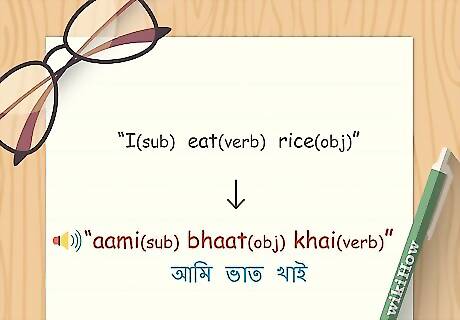
Use subject-object-verb word order in Bengali sentences. Linguistically, Bengali is referred to as a head-final language. This means that the verb comes after any objects of the verb. This differs significantly from English and other European languages, which use the subject-verb-object word order. Possessors, numerals, and adjectives come before nouns. However, articles (words similar to a, and, and the in English) come after the noun they relate to. This word order can be difficult for native English speakers. If you speak other head-final languages, such as Japanese, it might be easier. German also has some head-final verb phrases.
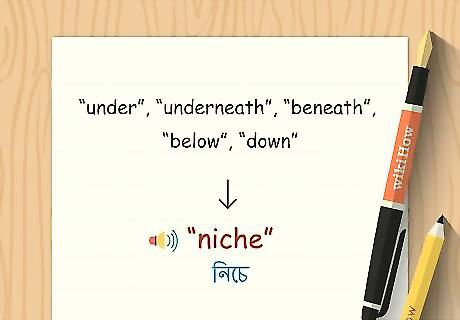
Distinguish Bengali postpositions from English prepositions. English and other European languages make use of prepositions and prepositional phrases. In contrast, these connecting words appear after the object in Bengali. For this reason, they are referred to as postpostitions. Bengali also has fewer of these words than exist in English and other European languages. For example, there is only one word in Bengali that is used to mean under, underneath, beneath, below, and down. Despite having fewer words, there are some situations in which a preposition would not be used in English at all, but a postposition is required under the Bengali grammar rules.
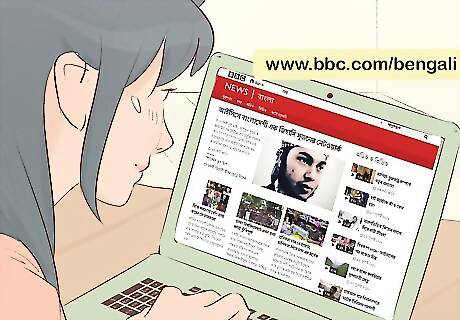
Read about news and current events in Bengali. Once you've learned the alphabet, you can start trying to read Bengali newspapers online. You may find it easier to read about events you already have some knowledge about. Bengali newspapers also give you a better understanding of the Bengali culture. The BBC has a news site in Bengali with text and videos, which may be a good place to start. Go to https://www.bbc.com/bengali.
















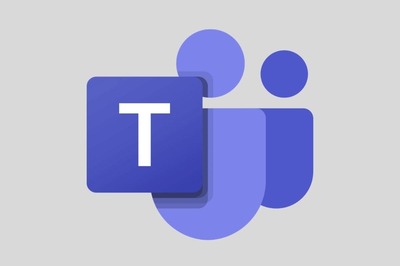



Comments
0 comment